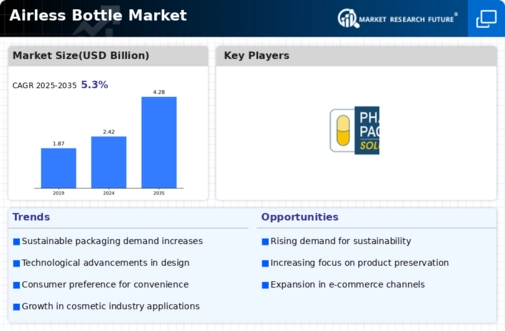Airless Bottle Size
Airless Bottle Market Growth Projections and Opportunities
The Airless Bottle Market is characterized by several different market factors which reflect the need for innovative packaging solutions and ever-changing preferences of consumers. One of the key drivers of this market is the increasing attention on product preservation and shelving life’s extension. Airless bottles are fitted with a pump system that prevents air from entering into the container, providing a protective atmosphere for formulations that are sensitive such as cosmetics and skin care products. This improves their stability and lifespan, thereby meeting customer demand for packages that ensure efficiency and freshness.
Consumer preferences for convenience as well as hygienic packaging contribute greatly to the growth of Airless Bottle Market. This also helps avoid contamination since the pump mechanism not only dispenses without exposure to air but also ensures accurate dosage control. Users can pull out products by themselves without having to use straws or tubes to enhance their overall experience of using it; these reasons have made customers like them most hence a shift towards this new trend in many areas especially beauty and personal care.
Technological advances in packaging design and manufacturing are important factors affecting the Airless Bottle Market. This includes materials innovations such as advanced plastics, eco-friendly alternatives that result in better looking products such as airless bottles. Smart package technologies like RFID tags for tracking product or indicator systems indicating how much product remains serve to enhance the functionality of airless bottles when integrated with them. Manufacturers have to be up-to-date with these technological advancements so as to meet changing needs within packaging industry.
The emphasis on premium and high-end goods by the cosmetic and skincare industry is another prominent factor driving or influencing the Airless Bottle Market. Packaging should protect luxury merchandise, while at the same time reflecting on brand identity along with values typical therein leading companies' minds. The upscale look and feel associated with airless bottles matched very well with expensive high-quality cosmetics along with skin-care formulations available on shelves today. This has driven adoption of such items among beauty & personal care premium segments.
Sustainability is increasingly becoming an issue in the packaging sector, which in turn affects the Airless Bottle Market. Both brands and consumers are looking out for packaging solutions that cause minimal harm to the environment. In this regard, airless bottles have been made by manufacturers using recyclable materials or those designed with sustainability principles. This transition to eco-friendly packaging is consistent with the wider industry objectives of lessening plastic waste as well as establishing circular economies.
Cost and economic considerations also shape market dynamics. Although airless bottles offer improved functionalities and benefits; their initial production cost may be slightly higher compared to traditional packaging formats. Market acceptance and penetration of airless bottles are influenced by economic stability, competition in the market and consumer willingness to pay a premium for innovative packaging solutions.
Several supply chain factors such as efficient manufacturing processes, raw material availability affect Airless Bottle Market. Manufacturers need stable supplies of components like pumps, containers or seals so as to meet demand for airless bottles. For delivery purposes, efficient logistics as well as distribution networks ought to be considered if people are to find such products in different industries; it entails cosmetics, pharmaceuticals & healthcare among others.






Leave a Comment